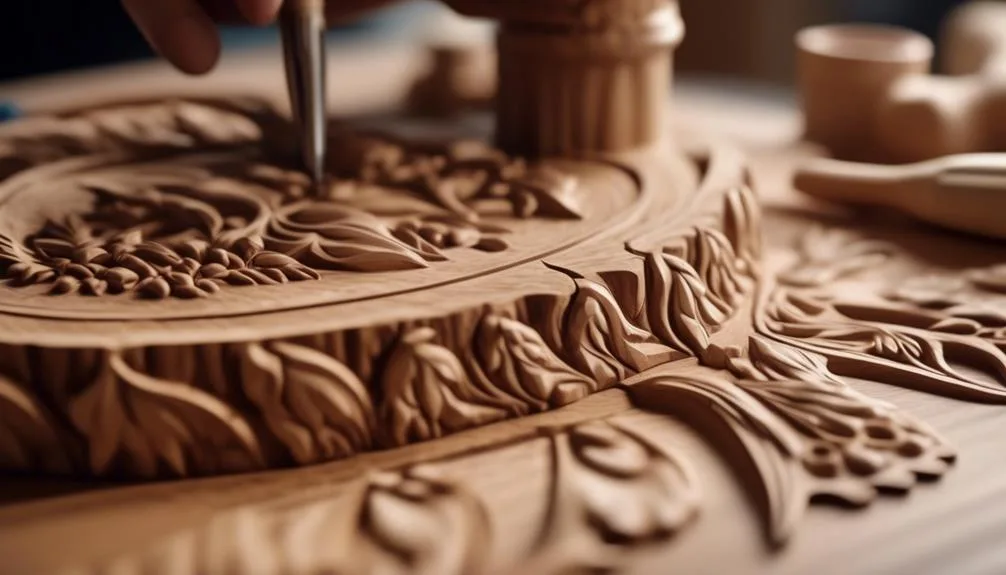Choosing the right wood for carving can be overwhelming. You need sturdy yet easy-to-work-with wood that allows for intricate details without sacrificing durability.
Sycamore wood seems promising with its fine grain and smooth texture. But is it the best choice for your carving project?
Let's explore sycamore wood's characteristics, suitability for detailed carving, and the best tools and techniques to bring out its versatility.
Characteristics of Sycamore Wood
Sycamore wood exhibits a beautiful, distinctive grain pattern that enhances the character of your wood carvings. The grain patterns in sycamore wood are known for their interlocking, wavy appearance, adding depth and visual interest to your carvings.
This unique characteristic makes sycamore an ideal choice for creating intricate designs with a touch of natural elegance. Additionally, sycamore wood has a moderate wood density, making it relatively easy to carve while still offering enough resistance to hold intricate details.
The balanced density also allows for smooth finishes, whether you prefer a natural wood look or a polished, glossy appearance. These combined features make sycamore wood a versatile and rewarding material for wood carving enthusiasts seeking both beauty and workability in their projects.
Suitability for Detailed Carving
With its moderate density and interlocking grain patterns, sycamore wood lends itself exceptionally well to intricate and detailed carving projects. The fine grain of sycamore wood allows for smooth and precise detailing, making it ideal for creating intricate designs with a high level of intricacy. When carving detailed patterns or delicate features, sycamore's fine grain ensures that the wood doesn't splinter or break, allowing for clean and precise cuts.
This makes it a popular choice for creating ornate decorations, fine furniture, and intricate sculptures. The wood's ability to hold intricate details without compromising its structural integrity makes it a top choice for woodcarvers who specialize in creating intricate designs. Whether you're crafting delicate filigree or fine relief carvings, sycamore wood's suitability for detailed carving is unmatched.
Tools and Techniques for Carving Sycamore Wood
Carving sycamore wood to achieve intricate designs and detailed patterns requires the use of specific tools and techniques that complement the wood's fine grain and density. When working with sycamore wood, it's essential to use the right tools and traditional carving techniques to bring out the best in this material.
Here are some key considerations:
- Wood carving tools: Invest in high-quality carving tools such as gouges, chisels, and carving knives with sharp edges to effectively work with the dense nature of sycamore wood.
- Traditional carving techniques: Embrace traditional carving techniques like relief carving, chip carving, and whittling to harness the natural beauty and fine grain of sycamore wood.
- Sharp tool maintenance: Regularly sharpen and maintain your carving tools to ensure clean and precise cuts in sycamore wood.
- Wood grain orientation: Pay attention to the grain orientation of sycamore wood and adjust your carving techniques accordingly for optimal results.
- Finishing techniques: Explore various finishing techniques such as sanding, staining, and sealing to enhance the beauty of your sycamore wood carvings.
Tips for Working With Sycamore Wood
When working with sycamore wood, it's crucial to carefully select the appropriate carving tools and techniques to achieve the best results. Sycamore wood has a fine texture and interlocking grain, so using sharp carving tools is essential to prevent tear-out and achieve smooth cuts.
Carving with the grain can also help minimize splintering and ensure cleaner results.
Additionally, when finishing sycamore wood, consider using a wood conditioner before applying any stain or sealant to ensure a more even and consistent finish. Due to its interlocking grain, sycamore wood can sometimes be a bit challenging to stain evenly, so testing different finishing options on scrap pieces of wood can help you find the best approach for your specific project.
Best Practices for Finishing Sycamore Carvings
For achieving a professional finish on your sycamore carvings, it's essential to carefully select the appropriate finishing techniques and products that enhance the natural beauty of the wood.
When finishing your sycamore carvings, consider the following best practices:
- Finishing Techniques: Use sandpaper to smooth the surface before applying any finish. This will help to achieve a uniform and polished look.
- Staining: Consider using a wood stain to enhance the natural grain and color of the sycamore wood. Choose a stain that complements the overall design of your carving.
- Sealing: After staining, seal the wood with a clear sealant to protect it from moisture and wear.
- Polishing: Once the sealant has dried, use a high-quality wood polish to bring out the natural luster of the sycamore wood.
- Attention to Detail: Pay attention to the details and ensure even coverage for a professional-looking finish.
Conclusion
To achieve detailed and intricate carvings, sycamore wood stands as an excellent choice. It has a fine grain, smooth texture, and is easy to work with. Using sharp tools and finishing with care will bring out the wood's natural beauty.
Happy carving!

My interest in trees started when I first saw the giant sequoias in Yosemite.
I was a teenager then, and I remember thinking, “I need to learn more about this.”
That moment stuck with me.
A few years later, I went on to study forestry at Michigan Tech.
Since graduating, I’ve worked in a mix of hands-on tree care and community education.
I’ve spent over ten years helping people understand how to plant, maintain, and protect the trees in their neighborhoods.
I don’t see trees as just part of the landscape.
They are living things that make a real difference in our daily lives.
